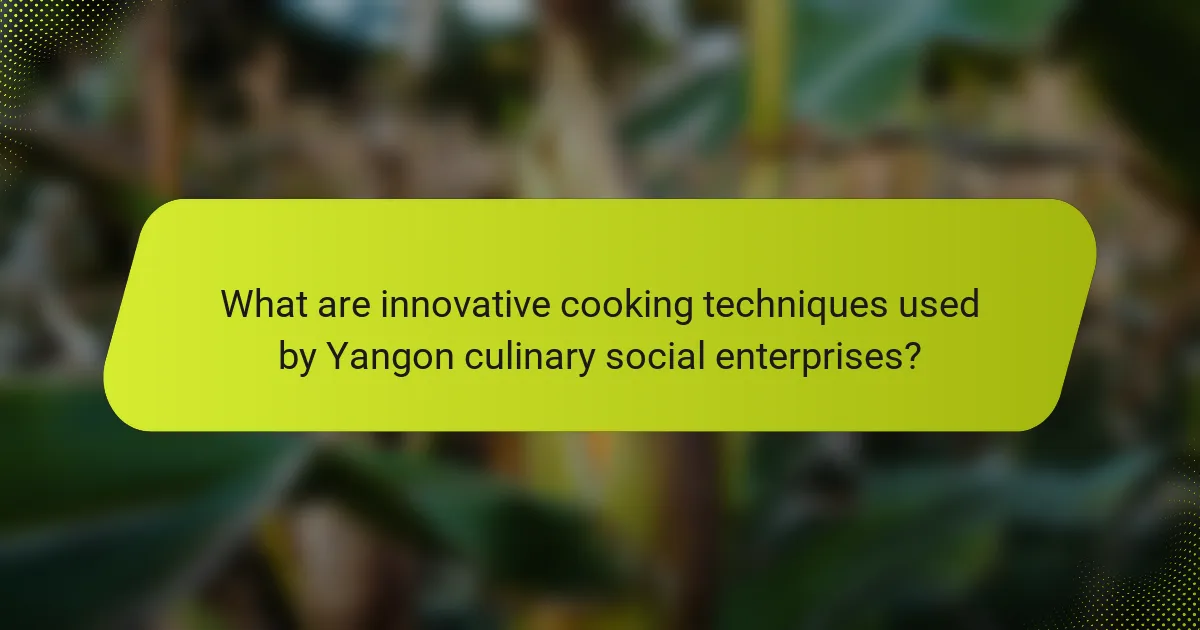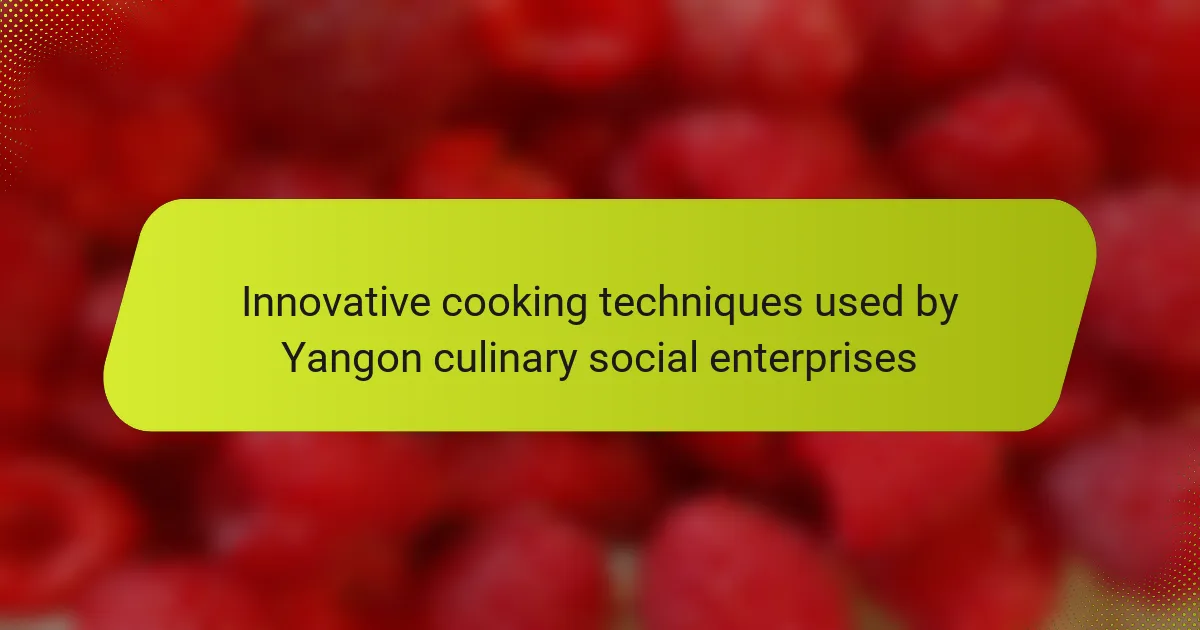Yangon culinary social enterprises are redefining the local food landscape through innovative cooking techniques such as fermentation, sous-vide cooking, and farm-to-table practices. Fermentation enhances flavors and preserves food, reflecting traditional Myanmar methods while incorporating modern approaches. Sous-vide cooking allows for precise temperature control, ensuring dishes are perfectly cooked and retain their moisture and flavor. Farm-to-table practices prioritize sourcing local ingredients, which supports community farmers and minimizes carbon footprints. These techniques collectively elevate the culinary experience while promoting sustainability and social responsibility within Yangon’s food ecosystem.

What are innovative cooking techniques used by Yangon culinary social enterprises?
Yangon culinary social enterprises utilize innovative cooking techniques such as fermentation, sous-vide cooking, and farm-to-table practices. Fermentation enhances flavors and preserves food, aligning with traditional Myanmar methods while adding modern twists. Sous-vide cooking ensures precise temperature control, resulting in perfectly cooked dishes that retain moisture and flavor. Farm-to-table practices emphasize sourcing local ingredients, supporting community farmers and reducing carbon footprints. These techniques not only elevate culinary experiences but also promote sustainability and social responsibility within the food ecosystem of Yangon.
How do these techniques differ from traditional cooking methods?
Innovative cooking techniques used by Yangon culinary social enterprises differ from traditional cooking methods in their approach and execution. These techniques often incorporate modern technology and creative practices. For instance, sous-vide cooking involves vacuum-sealing food and cooking it at precise temperatures, which enhances flavor and texture. This contrasts with traditional methods that rely on open flame or boiling.
Additionally, innovative techniques may emphasize sustainability, utilizing local and seasonal ingredients to reduce carbon footprints. Traditional cooking methods may not always prioritize these factors. Moreover, some social enterprises focus on collaborative cooking experiences, engaging the community in the process. This contrasts with the individualistic nature of many traditional cooking practices.
Overall, innovative techniques prioritize efficiency, sustainability, and community engagement, setting them apart from conventional cooking methods.
What specific innovative techniques are being implemented?
Yangon culinary social enterprises are implementing techniques such as sous-vide cooking, fermentation, and plant-based cooking. Sous-vide cooking involves vacuum-sealing food and cooking it at precise temperatures. This technique enhances flavor and retains nutrients. Fermentation is used to create unique flavors and preserve ingredients. It also promotes health benefits through probiotics. Plant-based cooking focuses on using vegetables and grains creatively. This technique reduces environmental impact and caters to growing dietary preferences. These innovative techniques are reshaping culinary practices in Yangon, promoting sustainability and health.
How do these techniques enhance food quality and sustainability?
Innovative cooking techniques enhance food quality and sustainability by optimizing ingredient use and reducing waste. Techniques such as sous-vide cooking preserve nutrients and flavors in food. This method allows for precise temperature control, ensuring that food retains its quality during preparation. Additionally, fermentation techniques improve shelf life and enhance flavor profiles, which can lead to reduced spoilage.
Sustainable sourcing practices are often a part of these techniques. By utilizing local ingredients, culinary social enterprises support local farmers and reduce carbon footprints associated with transportation. Studies indicate that local sourcing can cut transportation emissions by up to 50%.
Moreover, these techniques often promote plant-based meals, which are generally more sustainable than meat-based dishes. Research shows that plant-based diets can reduce greenhouse gas emissions by up to 70%. Therefore, the integration of innovative cooking techniques not only improves the quality of food but also contributes to environmental sustainability.
Why are Yangon culinary social enterprises adopting innovative cooking techniques?
Yangon culinary social enterprises are adopting innovative cooking techniques to enhance sustainability and improve food quality. These enterprises aim to reduce food waste through creative repurposing of ingredients. By utilizing modern cooking methods, they can maximize flavors while minimizing resource use. Innovative techniques also attract a broader audience, increasing customer engagement. Additionally, these methods often incorporate local ingredients, promoting community support. Studies show that culinary innovation can lead to economic growth in local markets. Thus, the adoption of these techniques aligns with both social missions and business viability.
What social and economic impacts do these techniques aim to achieve?
Innovative cooking techniques used by Yangon culinary social enterprises aim to achieve enhanced social cohesion and economic empowerment. These techniques foster community engagement by bringing people together through shared culinary experiences. They also create job opportunities, particularly for marginalized groups, thus improving livelihoods. By promoting local ingredients and traditional recipes, these techniques support local farmers and stimulate the economy. Research indicates that culinary initiatives can increase food security and nutrition within communities. Additionally, they often focus on sustainable practices, contributing to environmental conservation. Overall, these impacts lead to stronger, more resilient communities.
How do these techniques contribute to community engagement?
Innovative cooking techniques contribute to community engagement by fostering collaboration among local chefs and residents. These techniques often involve traditional cooking methods that resonate with the community’s cultural heritage. By incorporating local ingredients, social enterprises create a sense of ownership and pride among participants. Workshops and cooking classes encourage skill-sharing and knowledge exchange. This interaction builds relationships and strengthens community bonds. Evidence shows that culinary initiatives can increase local participation in events, enhancing social cohesion. Furthermore, these techniques can promote awareness of local food systems and sustainability practices, driving community action towards healthier eating habits.
What challenges do Yangon culinary social enterprises face in implementing these techniques?
Yangon culinary social enterprises face several challenges in implementing innovative cooking techniques. Limited access to quality ingredients hampers their ability to execute advanced culinary methods. Additionally, a lack of skilled labor restricts the effective application of these techniques. Financial constraints often result in insufficient investment in necessary equipment. Regulatory hurdles can complicate the adoption of new practices. Furthermore, consumer education is needed to foster acceptance of innovative dishes. These challenges collectively hinder the growth and sustainability of culinary social enterprises in Yangon.
What resources are necessary for successful implementation?
Successful implementation requires skilled personnel, quality ingredients, and appropriate kitchen equipment. Skilled personnel include chefs and staff trained in innovative cooking techniques. Quality ingredients ensure the final product meets consumer expectations. Appropriate kitchen equipment facilitates the execution of these techniques effectively. Additionally, financial resources are necessary to support training, procurement, and operational costs. A study by the World Bank highlights that investment in human capital significantly enhances productivity in culinary enterprises.
How do these challenges affect the overall success of the enterprises?
Challenges negatively impact the overall success of enterprises. These challenges can include resource limitations, market competition, and skill gaps. Resource limitations restrict access to quality ingredients and equipment. Market competition can lead to reduced customer base and lower profit margins. Skill gaps among staff can hinder the effective implementation of innovative cooking techniques. According to a study by the Asian Development Bank, 70% of social enterprises in Yangon struggle with resource allocation. This struggle directly affects their ability to innovate and grow. Consequently, these challenges can lead to decreased sustainability and limited outreach for the enterprises.
How do innovative cooking techniques influence customer perception and market trends?
Innovative cooking techniques significantly influence customer perception and market trends. These techniques enhance the dining experience by introducing unique flavors and presentations. For instance, molecular gastronomy captivates customers with visually stunning dishes. This novelty attracts food enthusiasts and encourages social media sharing. As a result, restaurants adopting these methods often see increased foot traffic and brand loyalty. Market trends indicate a growing demand for experiential dining, with 60% of consumers seeking unique culinary experiences. Innovative techniques also align with health trends, appealing to customers interested in nutritious options. This combination of creativity and health consciousness shapes consumer preferences and drives market growth.
What role does presentation play in consumer acceptance of these techniques?
Presentation significantly influences consumer acceptance of innovative cooking techniques. Well-presented dishes enhance visual appeal, which can attract customers. Research shows that appealing food presentation can increase perceived taste and quality. For instance, a study published in the journal “Appetite” found that visually appealing meals are often rated higher in flavor. Additionally, consumers are more likely to share aesthetically pleasing food on social media, increasing visibility and interest. Thus, effective presentation serves as a key factor in driving consumer engagement and acceptance of these culinary techniques.
How can social enterprises leverage these techniques for marketing purposes?
Social enterprises can leverage innovative cooking techniques for marketing by showcasing unique culinary offerings. These techniques can differentiate their products in a competitive market. For example, using local ingredients in creative ways can attract customers interested in sustainability. Highlighting these methods in promotional materials can enhance brand storytelling. Engaging with customers through cooking demonstrations can create memorable experiences. Additionally, social enterprises can utilize social media to share visually appealing content of their dishes. This approach can increase online engagement and attract a wider audience. By aligning their marketing strategies with their culinary innovations, social enterprises can effectively communicate their mission and values.
What are the future prospects for innovative cooking techniques in Yangon?
The future prospects for innovative cooking techniques in Yangon are promising. Increased interest in culinary arts is evident among local chefs and entrepreneurs. Social enterprises are emerging, focusing on sustainability and local ingredients. These enterprises often integrate traditional methods with modern techniques. For example, fermentation and preservation methods are being revived. Technology, such as sous-vide cooking, is gaining traction in urban kitchens. Workshops and training programs are being established to educate aspiring chefs. Additionally, the growing tourism sector is creating demand for unique culinary experiences. Overall, the combination of tradition and innovation is shaping a vibrant culinary landscape in Yangon.
How might these techniques evolve with changing consumer preferences?
Innovative cooking techniques used by Yangon culinary social enterprises may evolve to align with changing consumer preferences. As consumers increasingly prioritize sustainability, techniques will likely incorporate local, organic ingredients. Social enterprises may adopt methods that reduce food waste, such as utilizing by-products in new dishes. Additionally, the rise of plant-based diets could lead to more innovative vegetarian and vegan cooking methods. Technology integration, like smart cooking appliances, may become prevalent to enhance efficiency and precision. Consumer demand for unique dining experiences may drive experimentation with fusion cuisines. According to a 2022 report by the Food and Agriculture Organization, 60% of consumers are willing to pay more for sustainable food options. This trend reinforces the need for culinary techniques that reflect evolving values.
What potential collaborations could enhance the impact of these techniques?
Collaborations between Yangon culinary social enterprises and local farmers can enhance the impact of innovative cooking techniques. By sourcing fresh, local ingredients, these enterprises can improve food quality and sustainability. Partnerships with food educators can also amplify the reach of these techniques. They can provide workshops and training sessions, increasing community engagement. Collaborations with local restaurants can create platforms for showcasing these techniques. This can attract more customers and raise awareness. Additionally, teaming up with NGOs focused on nutrition can help in promoting healthy eating habits. These partnerships can lead to broader community benefits and increased visibility for the techniques.
What best practices should Yangon culinary social enterprises consider when adopting innovative cooking techniques?
Yangon culinary social enterprises should prioritize sustainability when adopting innovative cooking techniques. This includes sourcing local ingredients to support the community and reduce carbon footprints. They should also focus on training staff in new methods to ensure consistency and quality. Implementing feedback loops with customers can help refine techniques based on consumer preferences. Additionally, maintaining transparency in ingredient sourcing builds trust with patrons. Collaborating with local chefs can inspire creativity and enhance culinary offerings. Lastly, leveraging technology for efficiency can streamline operations and reduce waste. These practices align with the growing emphasis on responsible and innovative culinary approaches.
The main entity of this article is innovative cooking techniques employed by Yangon culinary social enterprises. The article explores various techniques such as fermentation, sous-vide cooking, and farm-to-table practices, highlighting their differences from traditional methods. It discusses how these techniques enhance food quality, promote sustainability, and foster community engagement while addressing challenges faced by social enterprises. Additionally, it examines the social and economic impacts of these methods, customer perceptions, and future prospects for culinary innovation in Yangon.
